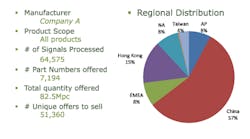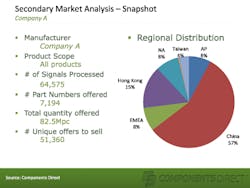Though counterfeiting has been a much talked about topic in recent months, it is also important to address the increasing growth of the gray market, as most believe that counterfeiting of electronic components is a bi-product of the gray market. The gray market, a known issue for technology manufacturers, is the unauthorized sale of new, branded products diverted from authorized distribution channels. A 2008 study by KPMG and the Alliance for Gray Market and Counterfeit Abatement (AGMA) reported that as much as $58 billion of technology products were passing through the gray market. This accounts for approximately 6% to 8% of the total market revenue. Applying this to the $300 billion semiconductor industry, the gray market impact on the components supply chain could be up to $20 billion annually.
High-tech companies aren’t the only ones that suffer from the gray market. Consumers and other technology end-users, including military and defense, are also negatively affected when products are advertised as new and authentic when in reality they could be used, refurbished or even worse, counterfeit. The repercussions of using counterfeit or non-conforming parts on product performance can be significant—and in the case of military components, catastrophic.
90 million units in the gray market
In a recent study conducted by Components Direct for a leading semiconductor supplier of both analog and digital devices, more than 90 million units of their product were found floating in the gray market across 7,000-plus part numbers. As seen in the graph below, although more than 80% of the product was found in Asia, 8% also appeared in both North America and EMEA (Europe, the Middle East and Africa). The product age spanned many years, with date codes of less than one year accounting for 29% of their gray market product (see the second graph below). A further 15% had date codes older than 11 years, demonstrating that whether you were an Original Equipment Manufacturer (OEM) looking for the newest product or a military sub-contractor looking for obsolete components, no end customer is immune to the presence of unauthorized product.
The magnitude of the gray market problem is prevalent in almost every product category. The ability to trace the product flow is limited as the supply chain offers numerous potential points of entry, and therefore multiple opportunities for counterfeiters or unscrupulous partners or individuals. In one example of rogue design houses, a company is established, positions itself as a design house, and is allowed to procure parts directly from an authorized distributor. The company will make it appear as though they are designing in a manufacturer-specific socket when in reality it is procuring parts and selling them to independent distributors—and taking requests from that same independent distributor regarding what parts to purchase.
Widespread impact of gray market activity
Left unchallenged, the gray market poses significant risks and long-term impact on the entire supply chain including:
Revenue.Where products are diverted from intended geographies or sold to the unintended end customer—allowing the end customer to receive a higher-than-normal discount—a brand owner’s revenue and profitability may be directly affected.
Cost. When gray market products require after-sales product support or warranty, it affects a company’s revenue and profitability because applicable support fees have typically not been paid.
Brand Reputation. When end users see differing price points for the same brand in the market it causes confusion and may negatively affect a brand value. And if a gray market product is not supported, then end users may be financially and operationally affected, thus lowering end-user satisfaction with the brand and potentially tarnishing a company’s reputation.
Liability and Risk. Buying from an unauthorized source increases the risk of counterfeit components due to the potential commingling that can occur in uncontrolled channels, resulting in risk to product quality, reliability and liability. The only way to combat this risk is to buy from a factory-authorized source.
The Solution: Direct Manufacturer Traceability
The November 2011 Senate Armed Services Committee findings have turned a spotlight on the issues of unauthorized and counterfeit components. Although further legislation will enable better “crackdown” on countries most at fault, utilizing manufacturer-authorized distributors is the best way to guarantee the authenticity of certified electronic components. Franchised distributors guarantee direct manufacturer traceability for all products, with pass-through warranties where needed, along with the best-in-class warehouse and process controls such as ISO 9001, ISO 14001 and ESD 20:20 certification. Additionally, technology platforms from distributors such as Components Direct provide suppliers with tools and data analysis that provide visibility into gray market activity across region, date code and vendors so customers can better mitigate the risks to their brand and bottom line. The gray market may never be eliminated completely, but the best guarantee against unauthorized and counterfeit parts is 100% direct traceability from the original manufacturers, eliminating the risks surrounding product quality, reliability and liability.
Steve Martin is executive vice president of sales for Components Direct, a factory-authorized source for excess and end-of-life semiconductor components based in San Jose, Calif. Components Direct is a franchised distributor and guarantees 100% direct manufacturer traceability on all parts. The company’s sophisticated "G2" analytics platform provides suppliers with unmatched visibility and control of the secondary market. Armed with detailed secondary market data by region, date code and vendor, suppliers can better mitigate risk, maximize revenue and protect their brand.










